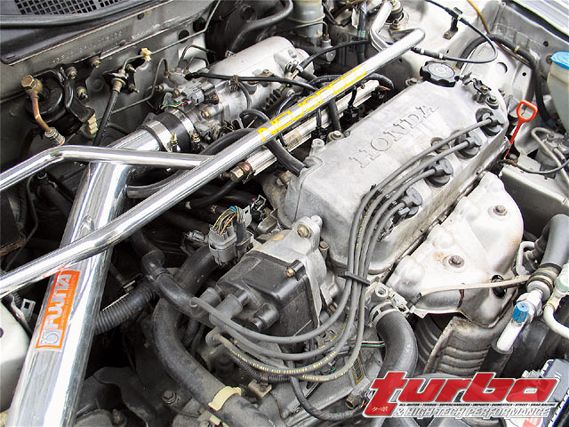 | Honda Civics - Swapping For Power
| Honda Civics - Swapping For Power Honda's dominance in the sub-compact market has been accredited with the simple ideology that an economical vehicle doesn't have to be just another boring commuter car. Appealing to a wide spectrum of individuals ranging from pubescent teens looking to accessorize their rides to the more subtle soccer moms taking their kids to a late afternoon practice, the Honda genre seemingly worked itself into any lifestyle. In 1996, Honda was at it once again - quickly reintroducing the newly redesigned Civic EK2 (chassis code) two-door coupe model. Sporting a newly redesigned exterior and creature comfort amenities that proved popular with consumers, it looked as if the 1996 Civic was destined towards automotive greatness. However, a kink in the armor was quickly revealed when more scrutinizing, performance-minded individuals popped the hood, and realized that the CX, DX, and LX models were equipped with a more checkbook friendly 1.6-liter (D16Y7 engine code) non-VTEC engine pushing a meager 106 hp.
It was clear that Honda engineers intended the D16Y7 engine to be an economical, eco-friendly powerplant - not a fire breathing monster. Why come to that conslusion? A good reason is found when looking at the D16Y7 intake manifold, and then comparing it to the D16Y8 intake found on the 1996-2000 Civic EX models. When comparing both units side by side, it's obvious that the Y7 intake runners were shaped for better low-end acceleration. Long, narrow, bowlegged runners fused to a small plenum accounts for the engine's lack of power from start to redline. On the other hand, a closeup examnation of the D16Y8 manifold found on the EX Civic shows it sporting a more familiar design. Unlike the unorthodox throttle body placement found on the Y7, the D16Y8 intake consists of shorter, yet larger runners with a straight forward design. A larger more consistent plenum and vertically mounted throttle body make for a manifold far more efficient at producing high rpm horsepower.
While all might seem lost for those who own Civics powered by a D16Y7, don't despair. Turbo has a rather simple solution for your underachieving engine that can help produce some respectable horsepower without breaking the piggybank.
We first began our testing phase by commandeering a 1997 Civic DX as our test mule vehicle. Strapping the vehicle down for a baseline pass on XS Engineering's Dynojet, the stock D16Y7 powerplant squeaked out an unimpressive 90.2 hp. With baseline numbers used to reference the progression of our Civic, we moved forward with the installation of an A'PEXi N1 exhaust system. Replacing the restrictive factory exhaust enabled us to uncork horsepower from the Civic with the largest gains coming in at 6 hp from 5800 to redline and a pickup of 3 to 4 lb-ft of torque from 3500 rpm through redline.
With the exhaust system in place, we moved on to the next order of testing which consisted of an F5 Fujita cold air intake system. A spin on the rollers netted a 6 hp and 7 lb-ft increase at 4300 rpm. Noticeable gains were once again graphed at 5500 rpm, where a consistent 6 hp and 4 lb-ft improvement was recorded. During our dyno run, the Civic encountered a hiccup that caused a loss in power from 4300 to 5300 rpm. This was primarily the fault of the D16Y7 intake manifold, which caused a counter reaction with the newly installed Fujita intake manifold. Due to the larger intake pipe diameter, the unit was now serving as the plenum source, which, coincidently, the Y7 manifold does not possess.
For our final testing, we swapped out the Y7 intake manifold in favor of the D16Y8 manifold and were awarded with a pleasant surprise. At 4300 rpm where our previous graph was showing a loss in power, the new Y8 replacement picked up the slack and netted a 6 hp and an 8 lb-ft gain. From 5500 to 6300 rpm a consistent 4 hp and 4 lb-ft was made over our original Y7 intake. Higher rpms were awarded with the improved design of the intake as the D16 power plant produced an additional 6 hp and steadily increased to a maximum 12 hp and 8 lb-ft ponies - only to be abruptly halted by the factory rev limiter.
By using a performance intake and exhaust and a stock Y8 intake manifold, our final output was brought to 105.9 hp and 99.3 lb-ft, respectively. These final numbers show a 15.7 hp and 4 lb-ft gain over our initial baseline run - not too shabby when you consider this SOHC 1.6-liter non-VTEC engine was designed with economy in mind.
